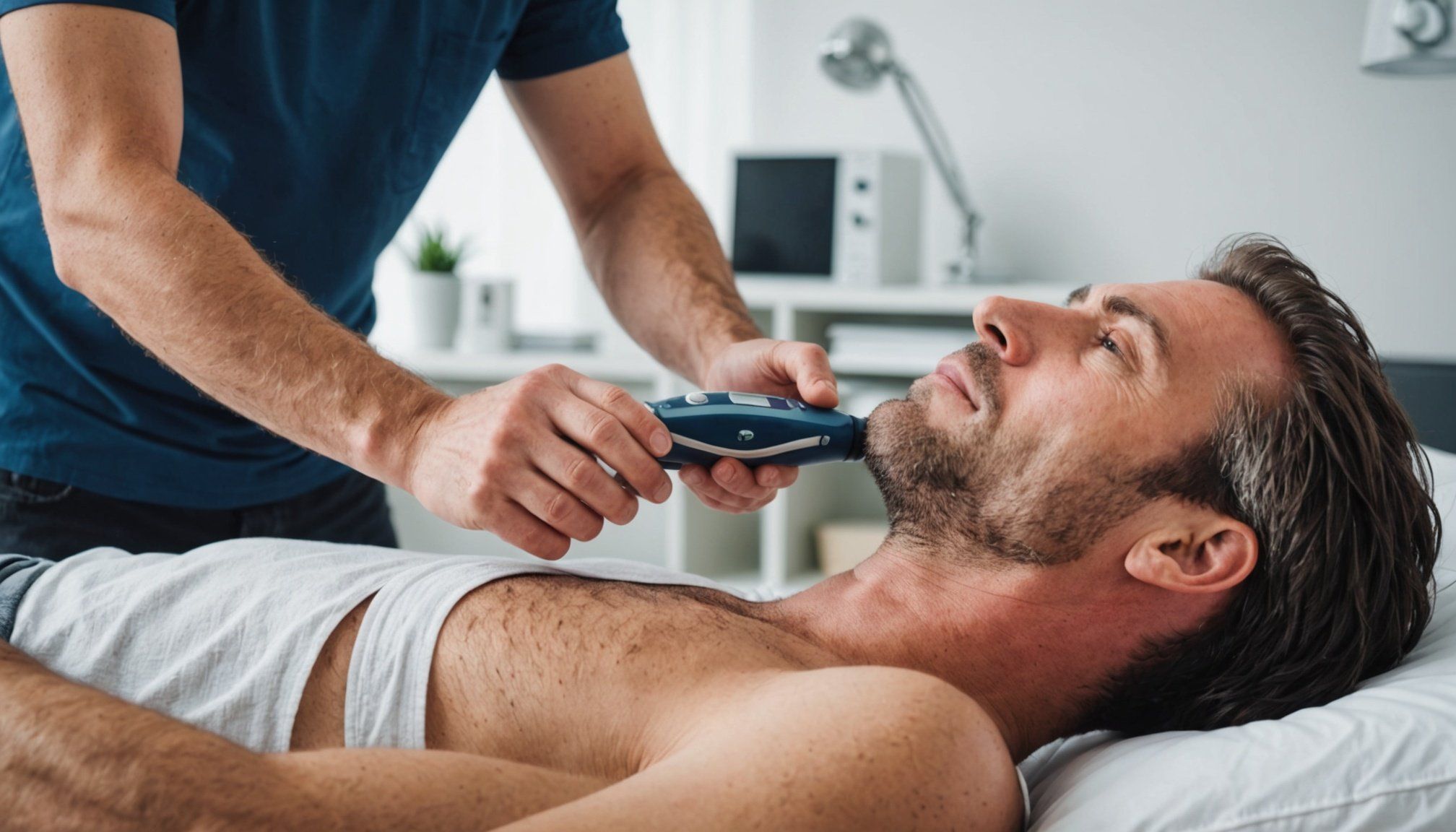Overview of Acoustic Wave Therapy
Acoustic Wave Therapy (AWT) is an innovative erectile dysfunction treatment that utilises low-intensity sound waves to enhance vascular function in the penis. By stimulating neovascularisation – the formation of new blood vessels – AWT promotes improved blood flow, which is essential for achieving and maintaining an erection. This mechanism of action is crucial, as it targets the root cause of many erectile dysfunction cases rather than just symptomatic relief.
The origins of this therapy can be traced back to its early application in urology, where it was initially used for lithotripsy to break down kidney stones. Over time, researchers discovered its potential benefits in treating various conditions, leading to its adaptation for erectile dysfunction. The therapy involves non-invasive sessions, typically lasting around 20 to 30 minutes, and requires no downtime, making it a convenient option for many patients.
Have you seen this : Exploring the Benefits: How Ongoing Blood Pressure Monitoring Can Transform Care for Hypertensive Patients
In summary, Acoustic Wave Therapy offers a promising mechanism of action for treating erectile dysfunction by enhancing blood flow through the stimulation of new vascular growth. Its roots in urology provide a solid foundation for its current application, offering patients a non-invasive alternative to more traditional treatments.
Efficacy of Acoustic Wave Therapy
The efficacy of Acoustic Wave Therapy (AWT) for erectile dysfunction treatment is supported by various clinical studies, which demonstrate promising patient outcomes. Research findings show that treatment success rates often surpass those of traditional methods, providing a viable alternative for those seeking non-invasive solutions. For instance, some studies report improvement rates as high as 70% in treated patients, showcasing AWT’s capacity to enhance erectile function substantially.
In parallel : Top Strategies for Effectively Managing Epilepsy in Children: Essential Best Practices
Patient outcomes from these trials have highlighted significant improvements in sexual performance and satisfaction. The therapy’s ability to target the underlying vascular issues rather than merely addressing symptoms is a notable advantage. Unlike oral medications which can have contraindications and side effects, AWT offers a treatment success that emphasises safety and efficacy.
Additionally, case studies often document patients experiencing long-term benefits from AWT, further affirming its potential as an effective therapy. While individual results can vary, the general consensus remains positive, thus encouraging further adoption of Acoustic Wave Therapy in clinical practice for treating erectile dysfunction.
Scientific Research and Clinical Trials
Acoustic Wave Therapy has been the subject of numerous clinical trials, showcasing its potential for treating erectile dysfunction. By examining various research findings, the therapy demonstrates a promising efficacy profile.
Notable Studies
Major studies have delved into the mechanism of action of Acoustic Wave Therapy, with results often indicating improved erectile function. One such study highlighted a 65% improvement rate, illustrating its effectiveness as a non-invasive option. These studies highlight the therapy’s potential to rival traditional methods.
Expert Opinions
While many medical studies underline the therapy’s positive impact, expert opinions vary. Some urologists champion its use, citing robust patient outcomes, whereas others call for further research to fully endorse it. Despite diverse viewpoints, many agree on its remarkable potential.
Limitations of Current Research
Despite promising results, current research has notable gaps. Critics point out limited long-term data and call for comprehensive trials to substantiate claims. Future studies need to address these concerns, ensuring a more complete understanding of its efficacy. By tackling these research limitations, the scientific community can confidently assess Acoustic Wave Therapy’s role in erectile dysfunction treatment.
Side Effects and Risks
Acoustic Wave Therapy is generally considered safe, with minimal side effects reported. The most common are mild, such as discomfort or slight redness at the treatment site, typically resolving quickly without intervention. Unlike some traditional erectile dysfunction treatments, treatment risks associated with AWT are relatively low, promoting it as a desirable option for many patients.
AWT does not carry the systemic side effects often linked to oral medications, such as headaches, dizziness, or gastrointestinal issues. Additionally, it avoids the invasiveness and recovery period associated with surgical options. This makes AWT an appealing alternative for individuals concerned about more severe treatment-related repercussions.
However, as with any medical procedure, patient safety should remain a priority. It is essential for individuals considering AWT to consult with healthcare providers to evaluate personal health conditions and potential interactions. Proper clinical oversight ensures the therapy is administered appropriately, minimising any possible risks and optimising outcomes. To sum up, Acoustic Wave Therapy presents a low-risk profile compared to many erectile dysfunction treatments, making it an attractive choice for patients prioritising safety.
Comparison with Other ED Treatments
When evaluating erectile dysfunction treatments, Acoustic Wave Therapy (AWT) stands out against conventional methods such as medications and surgical interventions. Traditional treatments like oral medications often provide temporary relief by increasing blood flow or enzyme activity but do not address the underlying vascular concerns. Medications may have side effects such as headaches or digestive issues. In contrast, AWT’s mechanism of action involves neovascularisation, aiming to treat root vascular causes directly without systemic side effects.
Surgical options, though effective for some, require significant recovery time and carry risks like infections or implant-related complications. AWT, being non-invasive, requires no downtime and has a lower side effect profile, making it appealing for those hesitant about surgery.
The long-term effectiveness of AWT and its general acceptance vary, as ongoing clinical trials examine its enduring impact. Despite this, it has garnered increasing attention for its potential to provide lasting benefits, setting it apart from options offering only short-term solutions. This comparative analysis encourages further discussion in the medical community regarding AWT’s position amongst available erectile dysfunction treatments.
Personal Testimonials
Patient Testimonials about Acoustic Wave Therapy (AWT) frequently highlight its transformative impact on sexual health. Many individuals report enhanced real-world experiences, appreciating the therapy’s non-invasive nature and improvement in erectile function. Success stories often mention a renewed sense of confidence and satisfaction, adding a personal dimension to clinical statistics.
Patients who underwent AWT describe the sessions as quick and painless, usually completed within 30 minutes. The absence of major side effects, as echoed in other sections, stands out in these patient testimonials, often contrasting sharply with experiences of traditional treatments. Such anecdotes reinforce AWT’s appeal for those seeking less intrusive options.
Accounts vary, however, as some users experience differing levels of improvement. These diverse success stories underscore the therapy’s potential but also suggest individual variability in outcomes. Factors such as the severity of erectile dysfunction, patient health, and adherence to a treatment course can influence effectiveness. Despite the variations, positive feedback remains prevalent, contributing to AWT’s growing reputation as a viable intervention.
Acceptance in the Medical Community
Acoustic Wave Therapy’s status in the medical community is evolving, reflecting both interest and caution among professionals. Recognised urological societies have observed the therapy’s potential, though comprehensive professional guidelines on its usage remain in development. These guidelines are crucial for informing practitioners about best practices and treatment protocols, ensuring patient safety and efficacy.
The therapy has garnered attention due to its less invasive approach compared to traditional methods. In terms of medical acceptance, it’s seen as a promising adjunct or primary therapy for erectile dysfunction, particularly for patients unresponsive to standard treatments. However, some practitioners highlight a need for more extensive research, pointing out that notable barriers to acceptance stem from insufficient long-term study results and a lack of consensus on treatment protocols.
Urologists and researchers continue to explore AWT’s potential, contributing to a gradual shift in professional opinions. As additional findings are published, the challenges of widespread adoption may lessen, particularly if future studies affirm current positive trends and address existing inconsistencies. This nuanced landscape underscores the need for further engagement and evaluation within the medical community.











